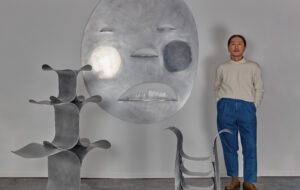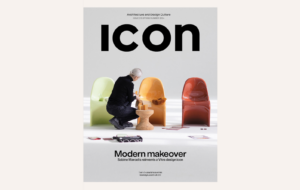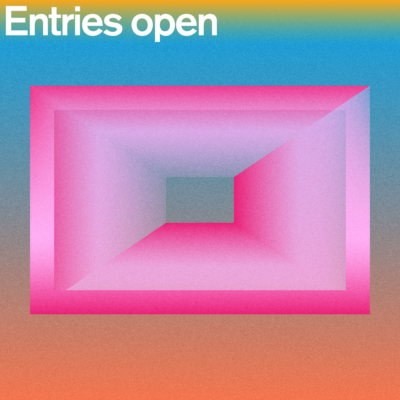


words Alex Wiltshire
Shin Azumi’s DVD player won’t work properly. He fiddles around with the on-screen menus in single-minded concentration rising frustration while Tomoko, his design partner and wife, waits with bemused patience for him to come and pose for icon’s photographer. But this is important for Shin: he wants to show the work of Scots-Canadian animator Norman McLaren, who for him encapsulates the Azumi’s approach to design.
Finally he cracks it, and with measured delight he plays a favourite film. “Norman McLaren for me achieved a balance of creating entertaining work that’s also artistic and conceptual – one of the few,” he says as the amusing simple repeated animations, set to music, are overlapped and modified to form a far more intricate and complex greater whole. Before he attended university, Shin wanted to be an animator along McLaren’s lines, but realised he didn’t have the patience. He goes over to an early self-produced design on the other side of the studio called Armchair=Table and demonstrates the way it gracefully transforms between two states. “We were conscious of how it moves, the beauty of movement,” he says. “In order to express the beauty of movement we wanted to make the style minimalistic.”
“But it is perhaps far away from what you call minimalist,” says Tomoko: complexity emerges from its minimal form. While it’s as uncomfortable to sit in as it looks, as Tomoko says, the enjoyment in having it is about the transformation. “For us the real value of this object is the movement and interaction.” They have taken this interest beyond product design and into performance arts, appearing once at the Edinburgh festival, and animation with their interactive zoetropes for a stand at 100% Design.
The Azumis, who have just been nominated for this year’s Jerwood Applied Arts Prize for furniture, design their furniture and products from their light and airy live/work studio off a scruffy road in Clapton, east London. The couple and their two assistants scuff softly around the wooden floor in slippers, surrounded by a comfortable clutter of books, papers and paper maquettes. The space, furnished with many examples of their work, feels in a shallow sense “typically Japanese”, a description the Azumis had difficulty accepting when they first came to the UK in 1992. “But we accept it these days if that recognition comes from the concepts and ideas behind our forms,” says Tomoko. “It’s natural, but we don’t want to be seen as adding Japanese features to our designs.” They are busy getting projects together for the Milan Furniture Fair, which will start two weeks after the interview. They include a bench called Volta for Lapalma using a new technology called 3D Ply, which allows plywood to be bent in any direction.
They graduated from the Kyoto City University of Art in 1989, Tomoko in Environmental Design and Shin in Product Design. During their studies they saw a travelling degree show by the Royal College of Art that opened them to a whole new way of thinking. Tomoko says: “It was really attractive but I didn’t really understand it. It was a totally different …”
“… Way of thinking about design,” Shin finishes. “It was a different attitude. What we were doing at that time was a just a preparation course to get a job.” The RCA exhibition offered a vision of a design philosophy that they recognised but didn’t yet understand. “So then we decided to study at the Royal College after a few experiences in Japan,” says Tomoko.
After their BA courses, Tomoko worked at architectural practices and Shin worked in the electronic giant NEC’s personal computer department where he designed the casing for the PC Engine Duo, the first CD-rom based videogame console. But in 1994 Shin began his course in industrial design at the RCA and Tomoko started a year later in furniture design, having decided that architecture worked on a scale too great for her: “I really like to look at things that are in human scale, things that you can touch,” she says.
They set up their studio in 1995 and have since increasingly merged their differing backgrounds. They married just before coming to the UK and work very closely. Whilst they have their own interests, they share most processes. “Our direction is getting closer and closer,” says Shin. “It wasn’t a big hassle to collaborate together and it’s quite easy to say, ‘Ah, this is rubbish’.” “We don’t say rubbish though; we say, ‘This could be better’!” says Tomoko, laughing.
A focus of their approach to new projects is the close observation of the way people behave in order to identify ways of improving existing designs. Shin picks up the teapot they designed for the range of tableware for Muji last year. He details the simple improvements to familiar objects that add greater usability. “Usually the handle cuts the other way but this is more ergonomically correct.” They also reduced the distance between the end of the spout and the handle so that it feels lighter. To lessen the damage caused by dishwashers to plates they thickened the edges and also developed a matt glaze for the range that isn’t marked by cutlery, a difficult task for the manufacturers to tackle.
Another example of simple innovation is in their popular LEM barstool for Lapalma, designed in 2000. Looking at stools, they found the footrests were often positioned in such a way that they were hard to climb and balance on. From this starting point they were led to thinking of ways of expressing the link between the footrest and the seat, a feature they realised would make LEM unique. They designed a steel loop frame that encloses a plywood seat and forms the footrest at the bottom. Bending a single piece of steel in two directions was a great challenge for Lapalma: “It was almost impossible,” says Shin, adding that LEM remains his favourite among their designs. “I’m quite satisfied with this one.”
The project was a challenge for the Azumis too: “I didn’t have a chair until I came here to the UK,” says Tomoko. Without having the concept of the chair ingrained in their culture, they have had to learn since what a chair means. Has this distance helped them think more objectively about chair design? “Could be,” says Shin. “We don’t have the preconception, the stereotypical image of the chair or seating. In a sense we are a bit freer. Could be.”
But Tomoko isn’t so sure. “Yeah but I don’t know about that – we know the history of the chair.” She is reluctant to attribute such generalisations to their work.
“I think so,” says Shin. “We are aware about the history but we know how to ignore it.” During our talk the Azumis dispute points quite often, their closeness emphasised by how quickly they agree to disagree. They are quickly onto the next subject: Tomoko’s favourite design from their collection, the Overture, again for Lapalma. She explains that she likes the way it transforms from a rolled cylinder for storage into a screen.
An emphasis on transformation and interactivity has become a keynote of their design. “We want not only to design something beautiful but something that people enjoy about it,” says Tomoko.
“In a sense invite people to use it and …” says Shin.
“… Be involved in it,” continues Tomoko. For the Azumis, beauty is just an aspect of a more pragmatic attitude to design based on finding the best solution. “We try to find some truth within a project,” says Shin “What is the best truth? The best solution within a limitation.” He dislikes the exposure of ego in design. “Ego is too much. We cannot say good or bad, but basically I don’t like it. I don’t like the person who says me, me, look at me.”
Tomoko agrees: “We want to get rid of things that talk too much of themselves. We feel it’s too aggressive, too noisy to live with.”
Soon after arriving in the UK they formed a performance art company called Vital Theatre, made up of students at Goldsmiths College and the nearby Laban dance centre. The company took a one-week show called Breath to the 1993 Edinburgh Festival. Three dancers with their features hidden by Lycra body suits improvised behind projections of water and other liquids that were manipulated live.
“We thought that the theatre is a more live phenomenon so we thought it is wrong if you overlay something which is recorded,” says Shin. While they were invited by several theatres around the world to perform for them, they haven’t done anything like it since. “It was very successful, but it wasn’t successful commercially,” says Tomoko. “You don’t earn any money. If there were commercial success perhaps we would take this way.”
Shin laughs. “We’re still looking for these kind of opportunities but it isn’t easy, it’s time consuming. But actually maybe we should have done two weeks, then we could have got some kind of award!”
At 100% Design in 2000 they merged their interests in animation and performance to design Keen’s stand. Keen didn’t have enough finished prototypes to show so the Azumis made zoetropes of each of the products, spinning drums with an animation sequence stuck on the insides, powered by someone on a bicycle. “We thought showing the furniture in film, two-dimensional, would be very flat. It doesn’t have the invested quality that finds your heart. So we wanted to show furniture with a more three-dimensional quality,” says Shin. By powering the zoetropes by the bicycle, they emphasised a form of communication between Keen and the public in which viewers could ask the cyclist to go faster or slower.
They often also take performance into presenting their work to clients, such as for Isokon Plus, for whom they updated their classic Donkey bookcase. “We used lots and lots of maquettes, 30 or more, and we traced our thinking process in front of him,” says Tomoko. “We wanted them to be involved in our thinking, because it was a very, very tough brief related to the history of Isokon.”
Do they use performance partly because English isn’t their first language? “Perhaps yes,” she says. “We couldn’t rely on language so we had to present ideas using other methods. And we also simply like performance. People concentrate better watching it.”
The Azumis’ wide range of influences and interests means they try not to restrict themselves to any particular fields of design. But at the moment Shin is particularly interested in exploring the design of interfaces between hardware and software, a concern that developed from his time at NEC. “That’s what I’m interested in at the moment, high-tech things,” he says, explaining that he is currently building his own computer from scratch.
“I think it is more with those interactive things,” says Tomoko, encouraging Shin to explain further.
“I think so too, the interactivity,” he agrees.
Also – if they had more time – they’d like to be able to do more theatre production, and perhaps interior and environmental projects. So there’s no particular direction they feel they’re going in at the moment? “We don’t define it at all, though we do want to expand the area we work with,” says Tomoko. “I guess it’s sort of childish to say we have no direction!”
“But what kind of direction do you expect?” says Shin, laughing hard. “Are you satisfied if we say we will conquer the world?”




















